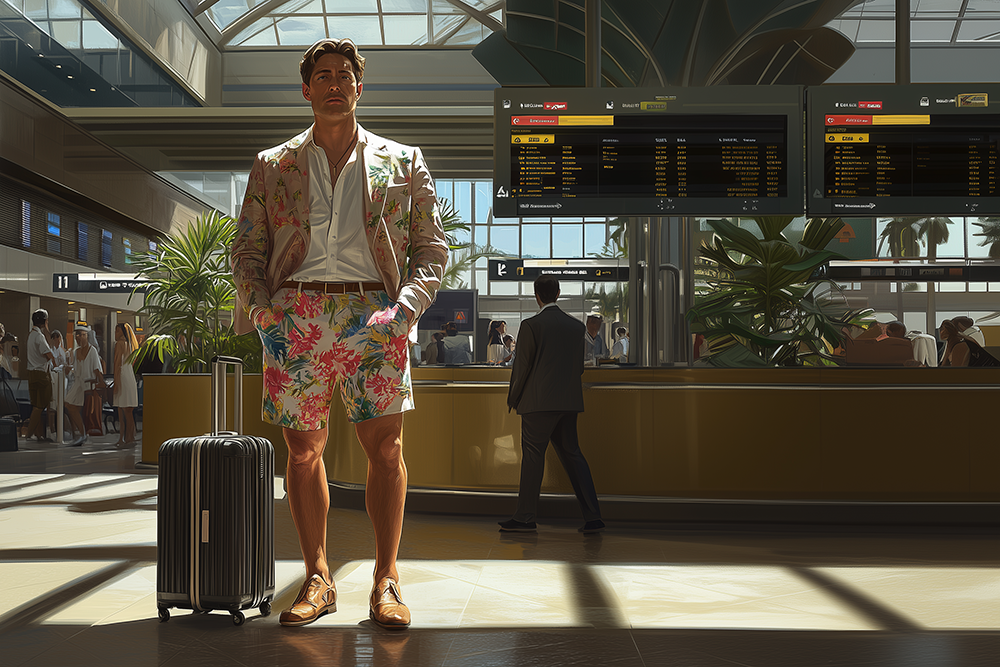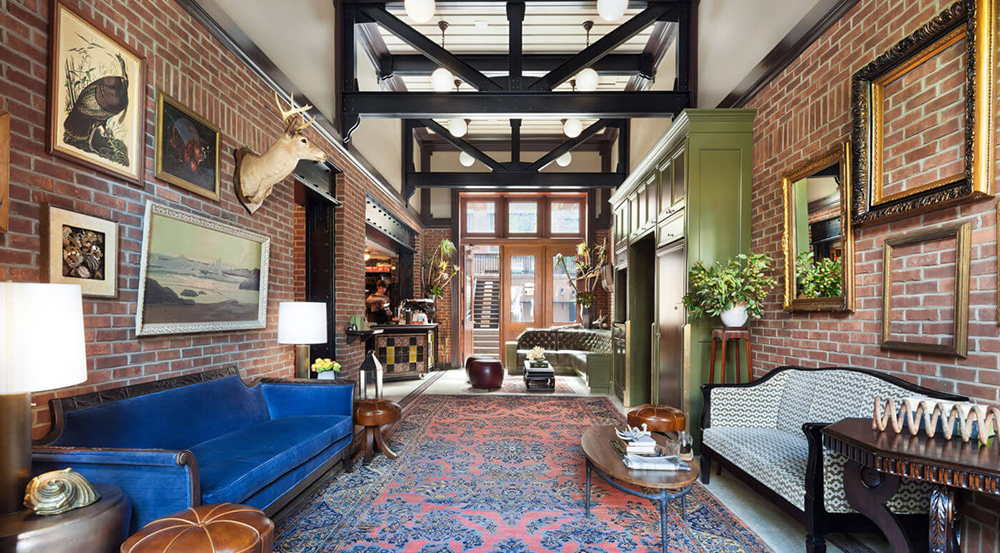
The Rise of Bleisure: Blending Business and Leisure
The Rise of Bleisure: Blending Business and Leisure Travel Post-Corona and Its Impact on Hotel Design
6 Guest Behavior Trends in Hotel Design in 2024
6 Hotel Technology Trends in 2024
Introduction to Trendy Interior Design Styles in 2024
Introduction
"bleisure" has become a popular travel trend over the last few years. Read more about trends here. Part corporate travel and part vacation, employees are increasingly requesting to add some downtime before or after a business trip.
But what percentage of corporate trips include an element of leisure time? What are the benefits of blending business and leisure trips to businesses, and what are the top reasons employees are so keen to use their vacation days after travelling for work? Read on for our list of bleisure travel statistics for 2024.

Bleisure in the Business Travel Market
Corporate travellers spend an average of 22 days travelling for work annually, and the average business trip lasts 3.8 days (SavvySleeper).
Pre-pandemic, 57% of businesses had travel policies allowing employees to add leisure time to their business trips (Forbes).
In 2021, 37% of corporate travellers from North America extended their business trips to do some sightseeing and other leisure activities (GBTA).
U.S. business travellers take over 405 million long-haul business trips annually. Employees are estimated to add vacation time to around 60% of these trips (243 million) (Stratos).
A Global Business Travel Association (GBTA) survey asked travel managers if they thought employees were more interested in blended travel post-pandemic. 82% of respondents answered that their teams were now equally or more interested in adding leisure time to their business trips (GBTA).
In the U.K., 45% of survey participants said they intended to add a leisure element to business trips in the future (Crowne Plaza).
In 2022, a U.S. survey found that 89% of participants wanted to include some vacation time on their next corporate trip (American Hotel & Lodging Association).
41% of travel managers have noted a rise in colleagues asking to add a longer stay to their work trips for leisure purposes (GBTA).
81% of business travellers are engaging in some variation of bleisure travel. 61% of travellers include leisure activities in their itinerary, while 41% are lengthening their stay to carve out some time off around their work trip (National Car).
The percentage of business trips that become a bleisure trip varies from country to country: 56% in the U.K., 65% in Germany, and 62% in China (Stratos).
In 2022, American Airlines revealed that almost half of its $13.46 billion revenue was generated from bleisure itineraries, a record high for the organization (AFA).
Compared to a 2019 survey, workers feel less pressured to hide the leisure elements of their trips from their boss (19% versus 21%) and their colleagues (22% versus 24%) (National Car).
79% of bleisure travelers state they volunteer more frequently for business trips where they can extend and enjoy some vacation time (National Car).
As the concept of bleisure gains traction, it's crucial for hotels to adapt their designs accordingly. This can include innovating hotel spaces to cater to both work and leisure. Also, incorporating personalized elements in hotel rooms can enhance the bleisure experience, making stays more comfortable and tailored to individual needs.
Which Business Need is the Origin of Most Bleisure Trips?
67% of bleisure trips begin as an itinerary to take in a conference. 46% start as a trip to external meetings and 42% as sales opportunities. Meanwhile, 30% of leisure travellers travel for an internal appointment, and 5% list their purpose as "other" (Stratos).
How Many Days Does an Average Bleisure Trip Last?
17% of bleisure trips last four nights or more, 31% are three nights long, 39% are for two nights, and just 12% of bleisure travellers are away for only one night (Stratos).
32% of bleisure stays are taken by frequent travellers who take one or two business trips each month (Expedia).
What Are the Top Destinations for Bleisure Trips?
Perhaps unsurprisingly, New York City generates the most bleisure trips yearly, with Paris and France coming in second and London and U.K. third (Statista).

Do Bleisure Travelers Travel Solo?
35% of bleisure travellers have company during their trips (Stratos).
36% of bleisure travellers have family or acquaintances in the destination (Stratos).
65% of survey participants said it was okay for friends or family to accompany corporate travellers on business trips as long as they didn't distract from work commitments (Visit Anaheim).
58% of male business travellers reported taking their partner on several business trips compared to 48% of female corporate travellers (National Car).
57% of employees confessed to looking to take business trips to destinations they know their loved ones would enjoy (Visit Anaheim).
Which Employee Demographic Engages Most with the Bleisure Travel Trend?
Engagement with bleisure travel varies from generation to generation, with Millennial employees (86%) more likely to add on leisure time than Gen Xers (76%) or Baby Boomers (73%) (National Car).
32% of bleisure trips are taken by frequent travellers who take one or two business trips each month (Expedia).
Senior leadership teams and executives are twice as likely to extend their leisure business trips than non-management employees (National Car).
Employees Consider Corporate Travel an Important Perk
86% of bleisure travellers see corporate travel as a critical component to career development, and 81% see it as crucial to cementing key business relationships that would be impossible without travelling for work (National Car).
Three-quarters of Millennial corporate travellers see travelling for business as a benefit of their role (Hilton Hotels & Reports Survey).
39% of bleisure travellers report they actively seek job roles that involve opportunities for business trips and are open to losing other benefits to have more chances to travel (National Car).
When asked whether they are willing to forego other perks in favour of more business travel, male employees emerge as more willing, with 21% stating they would accept a lower salary than the 10% reported from their female counterparts. 22% of male participants said they would receive a role with fewer vacation days versus 10% of females, and 28% of men said they would consider less flexibility around their work hours to take more work trips (National Car).
What Are the Most Common Motivations for Bleisure Travel?
When surveyed, 4 out of 5 corporate travellers responded that they felt they should be allowed to take some time for leisure during a work trip, and 79% believed their employer would agree (National Car).
65% of Millennial corporate travellers believe travelling for their company is linked to their sense of status (Hilton Hotels & Reports Survey).
For many employees, bleisure trips are linked to efforts to become more sustainable, with 60% of surveyed business travellers reporting that the pandemic has made them more conscious of the environmental impact of travelling (Crowne Plaza).
Bleisure travellers list their favourite elements of travelling for work as exploring a new destination (70%), making new connections (58%), changing their work environment (57%), and having new experiences (55%) (Visit Anaheim).
What Are the Benefits of Bleisure Trips?
Corporate travel is linked to employee satisfaction, with 90% of business travellers desiring to travel for work for the rest of their careers (SavvySleeper).
Close to 100% of business travellers report enjoying time spent on business trips (National Car).
A Hilton survey of U.S. travellers revealed that 76% of participants reported adverse outcomes if they went too long without taking time off. Burnout rated top with 41% of the vote, with boredom (36%), irritability (30%), and depression (29%) taking second, third, and fourth place (Hilton Hotels).
The same survey reported that just over half of American employees (51%) feel guilty when asking for time off, with 28% not taking all their vacation days. With these staggering stats, businesses encouraging bleisure travel could stand out as advocates for employee happiness and benefit from better engagement and retention (Hilton Hotels).
Employees of all demographics who combine leisure travel with their business trips reported a better work-life balance (91%) compared to respondents who didn't combine their vacations with travelling for work (79%) (National Car).
Bleisure travellers report returning to the office more refreshed than non-leisure travellers (54% versus 35%). This stat varies between demographics, with 55% of Millennials feeling invigorated by their bleisure trips compared to 48% of Gen Xers and 42% of Baby Boomers (National Car).
33% of workers stated they are more concerned with their physical and mental well-being since the Covid-19 pandemic. U.S. participants mainly reported that the last few years had increased their appreciation for travel for its mental health benefits (21%) (Crowne Plaza).
Bleisure trips can reduce the cost of accommodation for business trips. 82% of bleisure travellers will opt for the same hotel for the entirety of their journey, giving companies access to favourable rates for extended stays while sharing the spend. Organizations encouraging corporate travellers to sign up for loyalty programs and stay with their preferred hotel brands can access complimentary wi-fi, room upgrades, and late check-out (GBTA).
34% of surveyed business travellers shared that their most innovative concepts were conceived while on a business trip. This stat jumps to 53% for team members aged 16-24 (TravelPerk).
Designing Hotels for Bleisure Travelers
The rise of bleisure travel has significant implications for hotel design, with hospitality providers increasingly catering to the dual needs of business and leisure guests. Here are some key considerations:
1. Multi-functional Spaces: Hotels are integrating multi-functional spaces that can serve work and relaxation purposes. This includes comfortable and well-equipped business centres that can double as lounges or social areas in the evening.
2. Enhanced In-room Amenities: Rooms are being designed for extended stays. They feature work desks, high-speed internet, ample power outlets, luxury bedding, entertainment options, and kitchenettes for a home-away-from-home experience.
3. Wellness Facilities: Hotels emphasize well-being and enhance their wellness offerings. This includes on-site gyms, yoga studios, spa services, and healthy dining options to help travellers maintain their routines.
4. Leisure Activities: Hotels offer guests more leisure activities and excursions during their downtime. This includes curated local experiences, tours, and partnerships with local attractions.
5. Flexible Check-in/Check-out: To accommodate the varying schedules of bleisure travellers, hotels offer more flexible check-in and check-out times, allowing guests to maximize their time without the stress of rigid schedules.
6. Business Facilities: Enhanced business facilities such as meeting rooms, co-working spaces, and conference facilities are being integrated into hotel designs. These spaces have state-of-the-art technology to support remote work and business meetings.
7. Loyalty Programs: Hotels are developing loyalty programs tailored to bleisure travellers, offering points and perks for their stays' business and leisure portions. This encourages repeat business and fosters brand loyalty.
By addressing the needs of bleisure travellers, hotels can create a more appealing and versatile environment, attracting a growing segment of the travel market and ensuring guest satisfaction across both business and leisure dimensions.